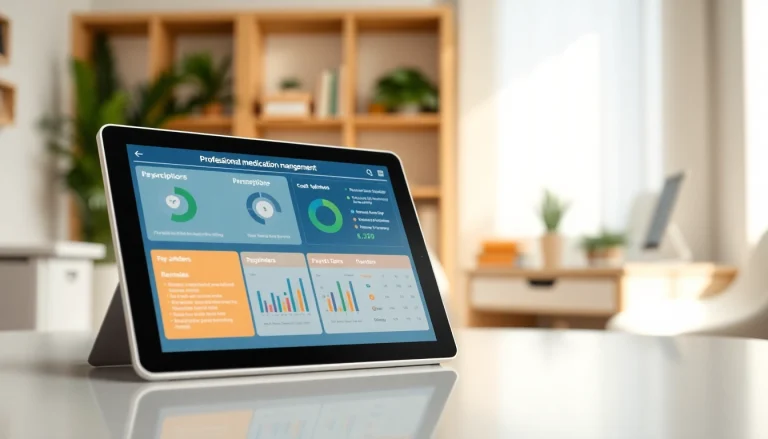
Understanding E-Prescribing: What Are the Best Eprescription Apps?
Definition and Importance of E-Prescribing
E-prescribing is the process of electronically generating and sending prescriptions to pharmacies for patients. This approach significantly enhances the prescription process by allowing healthcare providers to create and manage prescriptions digitally, using their computer systems or mobile devices. In recent years, the adoption of electronic prescribing has grown tremendously, driven by advancements in technology and the demand for more efficient healthcare solutions. Recognizing the importance of best eprescription apps can significantly streamline operations and improve patient outcomes.
Key Features of Effective E-Prescribing Apps
An effective e-prescribing app should encompass a range of crucial features that enhance usability and facilitate seamless prescription management. Some of these features include:
- User-Friendly Interface: The app should have an intuitive and easy-to-navigate interface, allowing healthcare providers to quickly create and manage prescriptions without extensive training.
- Drug Interaction Alerts: Many e-prescribing applications integrate databases that automatically check for potential drug interactions, which can prevent adverse reactions and enhance patient safety.
- Patient Medication History: Access to a patient’s history enables providers to make informed prescribing decisions by reviewing previous medications and treatment responses.
- Insurance Verification: E-prescribing apps can simplify the verification of patient insurance to ensure that prescribed medications are covered, thus reducing out-of-pocket expenses for patients.
- Refill Management: The ability to manage prescription refills electronically minimizes the need for patients to return to the office for adjustments, enhancing convenience and adherence to medication regimens.
Advantages of Using Digital Prescribing
The shift from traditional prescribing methods to digital platforms offers numerous advantages. Key benefits include:
- Improved Efficiency: Digital prescriptions eliminate handwriting errors and reduce the time spent on telephone calls between pharmacies and healthcare providers.
- Increased Safety: By minimizing human error and enabling quick access to patient histories and drug interaction checks, e-prescribing enhances overall patient safety.
- Cost Savings: E-prescribing reduces the overhead costs associated with paper-based systems, including printing, storage, and filing, thereby contributing to overall healthcare cost-efficiency.
- Enhanced Communication: Digital systems facilitate better communication among healthcare professionals, patients, and pharmacies, creating a more integrated healthcare delivery model.
- Regulatory Compliance: E-prescribing systems often come with built-in compliance features that help providers adhere to national regulations and guidelines.
Comparative Overview of the Best Eprescription Apps
Core Functionalities to Look For
When selecting the best e-prescribing apps for a medical practice, it’s essential to compare core functionalities. Evaluating these functionalities helps providers choose systems that align with their specific needs:
- EHR Integration: The ability of an e-prescribing app to integrate seamlessly with existing Electronic Health Record (EHR) systems is crucial to ensuring that patient data is consistent and easily accessible.
- Mobile Accessibility: As healthcare providers often work in various settings, mobile access to e-prescribing apps can significantly enhance flexibility and practicality.
- Customizable Templates: The option to customize prescription templates can save time and standardize data entry across different providers and practices.
- Reporting Features: Comprehensive reporting capabilities can help practices analyze prescribing patterns and make data-driven adjustments to improve service delivery.
User Experience: Navigating through Interface
The user experience is paramount when it comes to app functionality. A well-designed interface can significantly enhance workflow efficiency. Considerations in user experience should involve:
- Ease of Use: A relatively flat learning curve for healthcare professionals is essential, especially for those who may not be technologically savvy.
- Navigation Simplicity: Quick access to critical features like patient profiles, medication databases, and support materials ensures that healthcare providers can operate effectively.
- Feedback Systems: E-prescribing apps that incorporate real-time feedback systems can empower users to adapt and learn from their interactions with the platform.
Integration with Health Systems
Integration capabilities are vital to successful e-prescribing implementation. The best e-prescribing apps should be able to:
- Communicate with Prescription Management Systems: A smooth connection with pharmacy systems helps expedite the fulfillment of prescriptions.
- Synchronize with Health Information Exchanges: This ensures comprehensive patient data sharing across different health systems for continuity of care.
- Interface with Laboratory Systems: Integration with lab results can help inform prescribing decisions based on the latest patient health information.
Benefits of Implementing the Best Eprescription Apps in Practice
Improved Patient Care and Safety
By employing e-prescribing apps, healthcare providers can enhance overall patient care and safety. The following advantages are critical:
- Enhanced Medication Management: E-prescribing assists providers in ensuring that patients receive the correct medications by enabling easy access to up-to-date patient medication lists.
- Medication Adherence: Automated refill reminders and digital prescriptions increase the likelihood of patients adhering to their medication regimens.
- Reduced Errors: The reduction of illegible handwriting and the automatic alerts for drug interactions significantly diminish the risk of prescription errors.
Streamlined Workflow for Healthcare Professionals
Digital platforms notably enhance the workflow of healthcare professionals. Key factors include:
- Time Savings: E-prescribing applications expedite the prescription process, allowing providers to focus more on patient interactions instead of paperwork.
- Task Automation: Routine tasks like prescription renewals and authorizations can often be automated, freeing up valuable time for more critical duties.
- Collaboration Tools: Many e-prescribing apps come with integrated communication tools that facilitate collaboration within care teams.
Cost-Effectiveness and Efficiency Gains
Implementing the best e-prescribing apps can lead to significant cost savings and efficiency gains for healthcare practices:
- Reduction in Prescription Errors: Decreased liability from prescription errors leads to lower malpractice premiums and reduced costs related to remediation.
- Lower Administrative Costs: Fewer manual processes result in decreased administrative overhead, contributing to the overall financial health of medical practices.
- Improved Resource Allocation: Practices can allocate more resources to patient care rather than administrative tasks, thereby boosting the service quality.
User Perspectives: Feedback on the Best Eprescription Apps
Success Stories from Providers
Healthcare providers have shared numerous success stories following the implementation of e-prescribing systems. Key elements include:
- Increased Patient Satisfaction: Patients appreciate the quick turnaround of prescriptions, leading to greater loyalty and trust in their healthcare providers.
- Improved Care Coordination: Shared access to patient medication histories allows for better team collaboration, leading to holistic patient care.
- Data-Driven Insights: Providers have been able to analyze prescribing patterns to refine practices and ensure evidenced-based patient treatment approaches.
Challenges and Limitations Experienced
While the benefits are substantial, providers have also reported challenges associated with e-prescribing:
- Learning Curve: A transition period is often required for both providers and staff to become comfortable with the new systems, which may temporarily disrupt workflows.
- Technical Issues: System downtime or connectivity issues can impede the prescription process, leading to frustration among both healthcare workers and patients.
- Initial Costs: Implementation can involve upfront costs that may pose a financial challenge, especially for smaller practices.
Patient Experiences and Satisfaction
The feedback from patients regarding e-prescribing apps is overwhelmingly positive, with many noting key factors:
- Convenience: Patients appreciate the simplicity of sending prescriptions electronically, reducing wait times at pharmacies.
- Enhanced Communication: Open lines of communication through the apps improve patients’ understanding of their medications.
- Transparency: Patients feel more involved in their treatment plans, as they receive timely updates regarding their prescriptions.
Future of E-Prescribing: Innovations in the Best Eprescription Apps
Technological Advancements to Watch
The future of e-prescribing is poised for several key technological advancements that will further enhance effectiveness:
- Artificial Intelligence: AI algorithms are expected to improve drug interaction alerts and suggest alternative therapies based on patient-specific data.
- Blockchain Technology: Incorporating blockchain for secure patient data management could enhance confidentiality and reduce fraud risks.
- Voice Recognition Software: Integrating voice capabilities into e-prescribing can streamline the data entry process, making it faster and more intuitive.
Impact of Telehealth on E-Prescribing
The proliferation of telehealth services is transforming the landscape of e-prescribing:
- Remote Consultation: E-prescribing enables providers to prescribe medications during virtual consultations, increasing treatment access for remote patients.
- Integrated Care Models: Telehealth has led to the development of integrated care models where e-prescribing plays a central role.
- Patient Empowerment: Patients using telehealth services often feel more empowered to manage their healthcare, given the accessibility facilitated by digital prescriptions.
Preparing for Regulatory Changes
As regulatory frameworks around healthcare evolve, e-prescribing will need to adapt accordingly. Providers should prepare for these changes by:
- Staying Informed: Keeping abreast of new legislation and regulatory guidelines is critical for ensuring compliance.
- Updating Software: Regular updates to e-prescribing software may be necessary to align with changing regulatory standards.
- Training Staff: Regular training sessions for staff on compliance requirements and best practices in e-prescribing is essential to maintain high standards.






